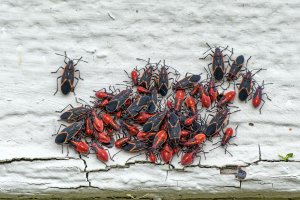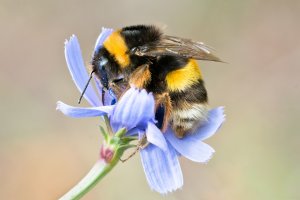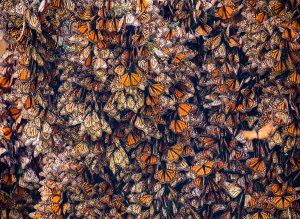To hide, to huddle, or to die… the many options for insects in winter.
October 4, 2023
Ali Groulx, Park Interpreter
When we think of winter survival, often the littlest organisms are overlooked. Maybe it is because they are so tiny, or maybe we have been conditioned to assume they all bite or sting; whatever the case, it is worth it to take a closer look at what insects do to survive the winter. Winter can be harsh for the insects who cohabit this world with us. There are steps that we, as humans, can take to help our teeny 6-legged, (possibly) winged, exoskeleton-covered pals survive the coldest of seasons so that they may see spring return once more!
You might be familiar with the influx of insects finding their way inside as fall dwindles into winter. Of course, if our homes did not exist, this would not be an issue; alas, insects are proficient at finding the cracks we never even knew existed. Native insects like box elders look to cracks for an overwintering paradise. Box elders enjoy trees in the maple family, and often feed on the sap, leaves, twigs, and seeds of maple tree species. Thankfully, they are harmless and typically do not harm the houses where they congregate. They enjoy hanging out in the sun and on reflective surfaces, and they hibernate during the wintertime in groups. Wintering box elders share the same behaviors with ladybugs, and non-native bugs like the brown-marmorated stink bug and the harlequin lady beetle. The round, orange harlequin lady beetle is native to Asia. These lady beetles use cracks in tall cliffs to survive the winter in their native region. In Michigan, they inhabit the closest thing to tall cliffs that they can find, which happens to be our human dwellings. They will not reproduce in our homes, though. When the weather warms up outside, they will leave, eventually laying eggs on the underside of a leaf.

Honeybees prepare their homes for the winter by blocking the ventilation they use for cool breezes in the summer. The population diminishes, but the honeybees that remain are bulky, having their bodies form in a way that allows them to only survive off honey or sugar alone. The larvae of the ‘winter bees’ are fed a low-protein diet, making their bodies develop in a way that creates a noticeably different bee. By controlling outside factors, the bees who rear the winter young change them in a way that benefits the colony and creates stronger immune systems with the hopes of surviving through the winter. After the fat winter bees are ready, and the temperatures drop, the bees will all huddle together to all remain the same temperature. The nurse bees will continue to take care of the brood as winter treks on. The bees who are on the outer layer of the bee-huddle can detach their wings and vibrate those muscles to generate heat. If these bees get cold, they can cycle into the middle of the huddle, and new bees will take over their job. As temperatures begin to slowly warm up, the fat winter bees can produce a food substance called ‘royal jelly’ to feed the brood of spring bees, even without pollen.
Wintering insects utilize materials that some people spend hours raking or getting rid of. Natural debris including leaves, logs, rocks, and tree bark serve as fantastic microhabitats for insects to survive. These structures can provide the nutrients the insects need, and the shelter that they require. Even though they are in the same family, bumblebees behave differently from the honeybees.

A colony of bumblebees cannot overwinter, so they will all die off… but the royalty among them will not. A bumblebee queen will overwinter in a tiny hole in the ground that is only big enough for her. She will be able to increase the amount of glycerol in her body, so she does not freeze solid. After she immerges, the queen bumble bee will search for a suitable nesting site. Overwintering insects can also enter diapause, too; this means that they can halt their lifecycle. They stop growing when the temperatures become unfavorable. As the seasons change and the temperatures rise again, they spring back to life like nothing even happened.
Instead of staying here to hibernate, the monarch butterfly takes a harrowing journey every fall. Believe it or not, migrating is an option, even for little insects. These little creatures can travel up to 100 miles a day and can take up to two months to fly to the warmer climates they need. Once they arrive around November, monarchs find their way to a small area in the mountains where they will overwinter. A monarch butterfly needs a good tree, a cool climate, and protection to overwinter successfully. They also require clouds and fog to deliver moisture and they prefer to overwinter in a forested area for protection from the wind and snow. Monarchs seek nectar in their overwintering environments, but they do not reproduce until they return to the north.

Insects are worthy of a closer look. The lengths that they go to survive the winter is no easy task. We can help Michigan insects in the ways that we take care of our yards, preparing them for the changing seasons. Leaving your leaf litter or piling it in a designated spot on your property can mean life or death for an overwintering queen bumblebee. And, although pesky and annoying at best, the insects who make it into our homes during the fall and winter are doing so for a reason; they are searching for a place to survive. You don’t need to share your human home with insects such as the harlequin lady beetle, but it is worth noting why these creatures are behaving in the way that they are. Even though they are small, even though they have many legs, insects deserve the best shot they can get at surviving the winter here in Michigan.
